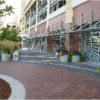Building Information
High-Performance Green Building
Location: 190 East Front Street, Suite 107, Boise, ID 83702
Size: 26,302 sq. ft.
Completion Date: August 2008
Telephone: (208) 287-7200
For More Information: Ada County Assessor
Building Features & Case Study

Download Case Study (pdf)
Prepared by: Selena O’Neal, CEM, LEED AP – Ada County Energy Specialist, Operations Department

LEED Certification
LEED-CI v 2.2 – Gold Certified
What is LEED?
Type: Office Space
Green Features: Natural daylighting with light shelves; Direct/Indirect light fixtures with T-5 lamps; High-efficient heating and cooling system; Enhanced building commissioning; Construction waste management; Office waste recycling
In 2008, Ada County undertook a major construction project to build out empty retail space and develop it into functional office space for the Assessors Office and Indigent Services. Planning began on the $2.8 million projects in early 2007 and construction was completed in July 2008. The project consisted of converting 26,000 square feet of unused shelled-in retail space into new office space, conference rooms, break rooms, restrooms with employee showers, and plenty of areas to provide as important county services for the taxpayers of Idaho. The new energy-efficient buildings and easy access layout encourage conservation while improving service and reducing wait times for customers.
The new space is located on the ground floor of the Civic Plaza apartment facility on Front Street in downtown Boise, Idaho. It is actually two distinct and separate departments with separate entrances and addresses. The Assessors Office contains 14,380 square feet and is located in the west part of the facility. The Indigent Services Department has 11,922 square feet and is located on the east side of the facility.
Both spaces were specifically designed and tailored to meet the needs of these unique departments and how they interact with the public. Each has a waiting area and counters with clerks who provide one-on-one, individual service. Much planning went into the design and development of the building to minimize its impact on the natural environment. More than 60% of the construction waste was recycled.
One of the best features of the existing core and shell was the extensive window space and southern exposure that provided ample amounts of natural daylight. Open office areas and employee cubicles were strategically placed along the south side of the building to minimize the need for artificial light by the building’s occupants. Exterior light shelves were installed to provide shade and also bring natural light deeper into space than traditional windows allow.
Ada County even went the extra step to incorporate items from the local utility’s incentive program and earned credit for energy efficient features such as occupancy sensors, self-luminous exit signs, a high-efficiency heating and cooling system, and building commissioning.
Leadership in Energy and Environmental Design
The new facility meets or exceeds the County’s program requirements of affordable, sustainable construction. It is actually less expensive to operate than traditional construction and provides a healthier environment for the occupants. The project is anticipating LEED certification (gold level) from US Green Building Council in early 2009. Some of the main LEED features of the project are listed below:
- Stormwater Management
Stormwater typically contains sediment and other contaminants that have a negative impact on water quality, navigation, and recreation. However, this building’s stormwater is collected and filtered on-site before flowing to a nearby pond for wildlife habitat and recreational use. Treating stormwater on-site reduces the demand on the municipal water conveyance and treatment systems. - Development Density
The building is located in an established, walkable community with a minimum density of 60,000 square feet per acre. The intent is to develop in areas with existing infrastructure, thereby protecting greenfields to preserve habitat and natural resources. - Public Transportation Access
The building is located within ¼ mile of two public bus lines. The intent is to reduce pollution and land development impacts from automobile use. Reduction of private automobile use reduces fuel consumption and the associated release of air and water pollutants from vehicle exhaust. In addition, parking lots produce stormwater runoff and contribute to the urban heat island effect. - Bicycle Storage & Changing Rooms
Secure bicycle storage with convenient changing and shower facilities is provided to employees. The intent is to reduce pollution and land development impacts from automobile use. - Water Use Reduction
The use of high-efficiency, low-flow sinks, toilets, and showerheads save thousands of gallons of water per year. Maximizing water efficiency reduces the burden on municipal water supply and wastewater systems. Reductions in water consumption minimize overall building operating costs. - Commissioning
A third-party (commissioning agent) tested and inspected the installation and operation of the building’s electrical and mechanical systems to verify that the project’s energy-related systems perform as intended. Properly functioning electrical and mechanical systems minimize overall building operating costs. - CFC Reduction in HVAC Equipment
There are no CFC-based refrigerants in the air conditioning systems. It is believed that CFCs cause serious environmental health problems. The reaction between a CFC and an ozone molecule in the earth’s stratosphere destroys the ozone and reduces the stratosphere’s ability to absorb UV rays. Overexposure to UV rays can be harmful to human health. Increased UV can also lead to reduced crop yield and disruptions in the marine food chain. - Optimize Energy Performance – Lighting & HVAC
The lighting system uses highly efficient light fixtures combined with harvesting natural daylight to lower operating costs, lower air conditioning loads and improves occupant wellbeing. The Heating, Ventilating, and Air Conditioning (HVAC) system uses highly efficient equipment to reduce the use of energy, also resulting in lower operating costs. The result is reduced environmental impacts associated with excessive energy use.
| Board of Ada County Commissioners | Ada County Assessors Office | Ada County Indigent Services | Ada County Operations | Design Team (Architect & Engineers) | General Contractor | Commissioning Agent |
|---|---|---|---|---|---|---|
| Fred Tilman Paul Woods Rick Yzaguirre |
Robert McQuade, Assessor | John Traylor, Director | Dave Logan, Director Bruce Krisko, Construction Manager |
CSHQA | Scott Hedrick Construction | Heery International |
